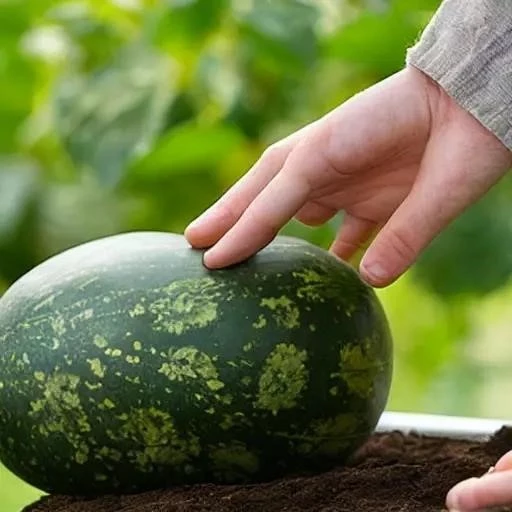There’s an almost magical allure to a perfectly ripe watermelon, its vibrant green rind hinting at the succulent, crimson flesh within․ It’s the quintessential taste of summer, a refreshing antidote to the season’s heat, and for many, a nostalgic centerpiece of backyard barbecues․ Yet, for countless aspiring gardeners, the dream of cultivating these magnificent gourds at home often feels like a sprawling challenge, a formidable task reserved only for seasoned agriculturalists with vast tracts of land․ The perception persists: watermelons demand an exorbitant amount of space, an ideal climate, and an almost intuitive understanding of their complex needs․
However, this widespread apprehension needn’t deter you from experiencing the unparalleled satisfaction of biting into a homegrown watermelon․ With strategic planning, a dash of modern gardening savvy, and an unwavering commitment to a few fundamental principles, cultivating your own sweet, crimson gems is not merely a distant dream but an incredibly achievable reality․ By integrating insights from expert growers and adopting remarkably effective techniques, even urban dwellers or those in cooler climates can transform their gardening aspirations into a bountiful harvest, proving that the future of your summer plate can be deliciously homegrown․
Here’s a detailed look at the essential requirements and innovative solutions for successful watermelon cultivation:
| Category | Key Insight / Recommendation | Reference |
|---|---|---|
| Optimal Soil | Rich, well-drained, sandy loam․ Essential for robust root development and nutrient uptake․ | The Old Farmer’s Almanac |
| Sunlight Requirement | Full sun, ideally 8-10 hours daily․ Sunny weather significantly enhances fruit sweetness․ | The Old Farmer’s Almanac |
| Temperature & Planting Time | Plant late spring to early summer, once soil temperatures consistently reach 70°F (21°C) or above․ Warm soil is crucial for early growth․ | The Old Farmer’s Almanac |
| Watering Technique | Regular, deep watering at the vine’s base in the morning․ Keep soil moist but not waterlogged․ Avoid overhead watering to prevent leaf diseases․ | The Old Farmer’s Almanac |
| Nutrient & Fertilization | Feed regularly with a balanced, liquid fertilizer like fish and kelp until fruits reach full size․ Avoid excessive nitrogen after flowering․ | |
| Space Management Solutions | Utilize raised garden beds, large containers (20+ gallon), or sturdy trellises for vertical growing․ Space plants 3-5 feet apart for optimal sprawling․ | |
| Average Yield Per Plant | Each healthy watermelon plant typically produces 2-3 harvestable fruits․ | Gardening Know How |
Cultivating the Ideal Environment: Sun, Soil, and Sustenance
Crucially, watermelons are sun worshippers, thriving in a generous eight to ten hours of direct sunlight daily․ Their vigorous growth is profoundly influenced by warm soil, a condition easily fostered by employing simple cloches or dark plastic mulches in cooler climates, thereby extending your effective growing season remarkably․ As seasoned gardeners often emphasize, a warm start prevents the dreaded growth slowdown that makes young plants susceptible to disease and pest pressures․ Beyond mere sunshine, these thirsty gourds demand consistent moisture without ever becoming waterlogged․ Experienced cultivators consistently advocate for deep, morning watering directly at the vine’s base, meticulously avoiding leaf contact and overhead irrigation to mitigate fungal risks․
The foundation for sweet, juicy fruit lies beneath the surface․ Watermelons flourish in relatively rich, well-drained sandy soil, mimicking their natural arid habitats․ Before planting, enriching your soil with compost or well-rotted manure provides an invaluable nutrient boost, establishing a robust environment for root expansion․ Furthermore, a balanced feeding regimen, perhaps incorporating a nutrient-rich liquid fish and kelp fertilizer, remarkably boosts fruit development until full size is achieved, as noted by various industry experts․ This careful attention to both hydration and nutrition is paramount, ensuring that each developing fruit receives the sustenance it needs to mature into a delicious summer treat․
Defying Space Constraints: Innovative Solutions for Every Garden
The often-cited challenge of “too much space” is, for many innovative gardeners, an exciting opportunity for creative solutions rather than a genuine impediment․ Whether you’re considering a meticulously designed raised bed, allowing the vibrant vines to cascade gracefully over the edges, or experimenting with robust container gardening, where specific compact varieties like ‘Sugar Baby’ or ‘Bush Sugar Baby’ flourish, ample space is surprisingly negotiable․ Experienced growers like Kevin and Paul, popular figures in the online gardening community, frequently demonstrate how even massive watermelons can be successfully nurtured in appropriately sized containers (think 20-gallon or larger), provided they receive consistent care and fertilization․ Even vertical gardening, utilizing sturdy trellises, transforms limited plots into prolific producers, defying traditional sprawling expectations and presenting a visually stunning display․
For those gardening in cooler, northern latitudes, the dream of colossal watermelons needn’t be deferred․ Selecting early-maturing or ‘mini’ varieties, coupled with the strategic use of season-extending techniques like row covers or cold frames, dramatically increases your chances of a sweet, satisfying harvest․ These ingenious methods create microclimates that trap heat, giving sensitive watermelon plants the warmth they crave, proving that even challenging climates can yield delightful results․ By embracing these adaptable strategies, gardeners everywhere can overcome environmental hurdles, confidently cultivating their own slice of summer․
The Sweet Reward: Harvesting Your Homegrown Treasure
The culmination of your diligent efforts arrives with the harvest, a moment brimming with anticipation․ Identifying a ripe watermelon involves a symphony of sensory cues: a dull, hollow thud when tapped, a distinct yellowing on the bottom where it rested on the soil, and a drying tendril nearest the fruit stem․ Trusting these indicators, honed by generations of gardeners, ensures you pick your watermelons at peak sweetness, capturing that elusive, fresh-from-the-vine flavor that supermarket varieties simply cannot replicate․ Each fruit picked represents not just a successful harvest, but a triumph of patience, knowledge, and dedication․
Embracing these sophisticated watermelon gardening tips transforms the arduous into the enjoyable, promising a summer replete with juicy, homegrown delights․ Venture forth, armed with knowledge and optimism, and witness your garden flourish, delivering the unparalleled taste of victory in every sweet, refreshing bite․ The future of your garden is ripe for the picking, offering an endless bounty of delicious possibilities․






